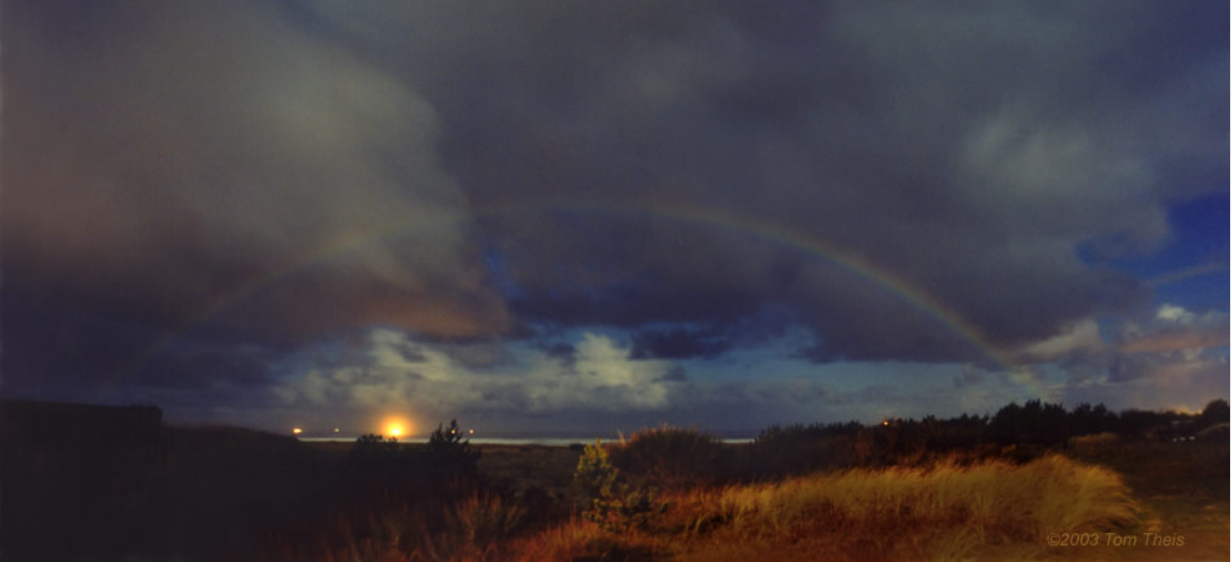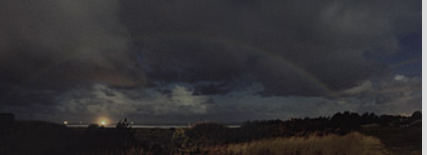Moon - Lunar Rainbow
Moon - Lunar Rainbow: A Rare and Enchanting Nighttime Phenomenon
Have you ever wondered if rainbows can appear at night? While we are accustomed to witnessing the vibrant colors of rainbows during the day, there exists a captivating and elusive counterpart that emerges under the moonlit sky - the lunar rainbow, also known as a moonbow. This ethereal spectacle occurs when moonlight interacts with raindrops, creating a celestial arc of soft, ghostly hues.
The key ingredient for the formation of a moonbow is, unsurprisingly, the moon itself. Just as sunlight produces rainbows during the day, moonlight can generate these nocturnal wonders. However, moonbows are exceptionally rare due to the relatively dim nature of moonlight. To catch a glimpse of this enchanting phenomenon, several conditions must align perfectly:
- Moon Phase: A nearly full moon is necessary for sufficient illumination.
- Rainfall: Rain must be falling opposite the moon.
- Dark Sky: The sky should be sufficiently dark, free from excessive light pollution.
- Moon's Altitude: The moon must be below 42 degrees above the horizon.
When these elements harmoniously come together, they give rise to the elusive moonbow, which may grace the night sky for a fleeting moment. However, due to the low intensity of moonlight, moonbows are often perceived by the naked eye as colorless or very faint. Yet, under particularly bright lunar conditions, observers have reported glimpses of subtle hues.
Capturing the beauty of a moonbow in photographs can be challenging, but not impossible. Skilled photographers like Thomas Thies have managed to immortalize these mesmerizing displays. Thies beautifully captured a moonbow over the ocean in Gearhart, Oregon on December 8th, 2003. Lasting approximately 20 minutes, this remarkable event unfolded with the moon rising behind the observer, while crab boats dotted the horizon with their bright yellow lights.
To comprehend the formation of a moonbow, it is essential to understand the physics behind it. When moonlight encounters raindrops, a process known as refraction occurs. This bending of light causes the different wavelengths within the moonlight to separate and disperse, ultimately forming a circular arc of colors. However, due to the dimness of moonlight, the resulting moonbow is often faint and delicate in comparison to its daytime counterpart.
While moonbows are an enchanting spectacle on their own, they can also be accompanied by other atmospheric phenomena. In some instances, observers have reported the simultaneous appearance of a moonbow and a lunar halo. These halos manifest as luminous rings encircling the moon, caused by the diffraction and refraction of moonlight through ice crystals present in high-altitude clouds.
Although moonbows are infrequent occurrences, they have captivated the imaginations of poets, artists, and dreamers throughout history. The elusive nature of these ethereal rainbows adds to their allure, making them a subject of fascination for skywatchers and photographers alike. The rarity of moonbows serves as a reminder of the delicate interplay between light, water, and the celestial bodies that grace our night sky.
So, next time you find yourself under a starlit canopy on a rainy night with the moon peering through the clouds, keep an eye out for this magical phenomenon. While you may need a stroke of luck to witness a moonbow firsthand, its elusive beauty will undoubtedly leave an indelible impression on your soul.
Moonbow - Lunar Rainbow

We have all seen rainbows during the day but what about rainbows at night? Thomas Thies of Gearhart, Oregon photographed this one after the sun had set on December 8th 2003. He says, "The rainbow, which lasted for about 20 minutes, was out over the ocean with the moon rising behind us." The several bright yellow lights near the horizon are crab boats.
The moon is the key, just as sunlight produces rainbows during the day, moonlight can produce rainbows at night. This is a lunar rainbow or 'moonbow'. Another moonbow image.
Moonbows are rare because moonlight is not very bright. A bright moon near to full is needed, it must be raining opposite the moon, the sky must be dark and the moon must be less than 42º high. Put all these together and you do not get to see a moonbow very often! To the unaided eye they usually appear, as in the small image, without colour because their light is not bright enough to activate the cone colour receptors in our eyes. Nonetheless colours have been reported and might be seen when the moon is bright.

Simulated naked eye view
Note: this article has been automatically converted from the old site and may not appear as intended. You can find the original article here.
Reference Atmospheric Optics
If you use any of the definitions, information, or data presented on Atmospheric Optics, please copy the link or reference below to properly credit us as the reference source. Thank you!
-
<a href="https://atoptics.co.uk/blog/moon-lunar-rainbow/">Moon - Lunar Rainbow</a>
-
"Moon - Lunar Rainbow". Atmospheric Optics. Accessed on April 27, 2024. https://atoptics.co.uk/blog/moon-lunar-rainbow/.
-
"Moon - Lunar Rainbow". Atmospheric Optics, https://atoptics.co.uk/blog/moon-lunar-rainbow/. Accessed 27 April, 2024
-
Moon - Lunar Rainbow. Atmospheric Optics. Retrieved from https://atoptics.co.uk/blog/moon-lunar-rainbow/.